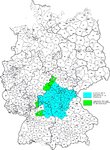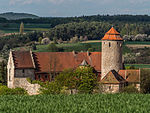Franconia (German: Franken, pronounced [ˈfʁaŋkŋ̍] (listen); Franconian dialect: Franggn [ˈfrɑŋɡŋ̍]; Bavarian: Frankn) is a region of Germany, characterised by its culture and Franconian dialect (German: Fränkisch).The three administrative regions of Lower, Middle and Upper Franconia (largest cities, respectively: Würzburg, Nuremberg and Bamberg) in the State of Bavaria are part of the cultural region of Franconia, as are the adjacent Franconian-speaking South Thuringia, south of the Rennsteig ridge (largest city: Suhl), Heilbronn-Franconia (largest city: Schwäbisch Hall) in the state of Baden-Württemberg, and small parts of the state of Hesse.
Those parts of the Vogtland lying in the state of Saxony (largest city: Plauen) are sometimes regarded as Franconian as well, because the Vogtlandian dialects are mostly East Franconian. The inhabitants of Saxon Vogtland, however, mostly do not consider themselves as Franconian. On the other hand, the inhabitants of the Hessian-speaking parts of Lower Franconia west of the Spessart mountains (largest city: Aschaffenburg) do consider themselves as Franconian. Heilbronn-Franconia's largest city of Heilbronn and its surrounding areas being South Franconian-speaking, those are only sometimes regarded as Franconian.
Franconia's largest city and unofficial capital is Nuremberg, which is contiguous with Erlangen and Fürth, with which it forms a large conurbation, with around 1.3 million inhabitants.
The German word Franken—Franconians—also refers to the ethnic group, which is mainly to be found in this region. They are to be distinguished from the Germanic tribe of the Franks, and historically formed their easternmost settlement area. The origins of Franconia lie in the settlement of the Franks from the 6th century in the area probably populated until then mainly by the Elbe Germanic people in the Main river area, known from the 9th century as East Francia (Francia Orientalis). In the Middle Ages the region formed much of the eastern part of the Duchy of Franconia and, from 1500, the Franconian Circle. The restructuring of the south German states by Napoleon, after the demise of the Holy Roman Empire, saw most of Franconia awarded to Bavaria.









